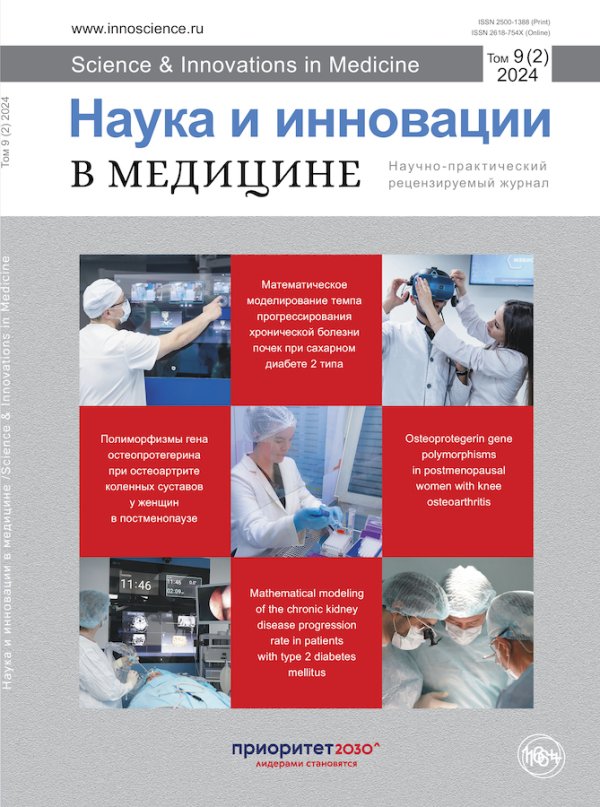Features of liver fibrosis in co-infections with human immunodeficiency virus and hepatitis B or C viruses
- Authors: Feoktistova E.P.1, Konstantinov D.Y.2
-
Affiliations:
- Samara State Medical Universit
- Samara State Medical University
- Issue: Vol 9, No 2 (2024)
- Pages: 110-116
- Section: Infectious diseases
- URL: https://ogarev-online.ru/2500-1388/article/view/259283
- DOI: https://doi.org/10.35693/SIM595868
- ID: 259283
Cite item
Full Text
Abstract
Aim – to assess the effect of the order and time of HIV/HCV and HIV/HBV co-infections, as well as the antiretroviral therapy regimen on the progression of fibrotic changes in the liver.
Material and methods. The object of the retrospective-prospective clinical study was 204 HIV/HCV co-infected patients, and 30 HIV/HBV co-infected patients, divided into groups according to the type of viral pathogen that first entered the patient's body. The criterion for assessing the patients' condition was the type of the liver fibrous process (progressive, stable, regressing) according to the annual transient ultrasound elastography of the liver.
Results. It was found that the order of pathogens entry significantly affected the progression of liver fibrosis. The least favorable situation arose when the first pathogen was HIV, and the interval between the entry of viral pathogens into the patient's body was more than 5 years. The degree of the fibrotic process progression was also influenced by the combination of drugs with different action mechanisms for antiretroviral therapy.
Conclusion. The risk of progressive liver fibrosis in HIV/HCV co-infection patients was associated with a situation where the first infecting pathogen was HIV, and an interval between co-infections was more than 5 years. In this case, the most optimal antiretroviral therapy regimen was a combination of nucleoside reverse transcriptase inhibitors with integrase inhibitors.
In HIV/HBV co-infection, the risk group for progressive liver fibrosis included patients having HIV as the first pathogen and an interval between co-infections 5-10 years, as well as patients having HBV as the first pathogen with an interval between the infectious agents more than 10 years. The most optimal regimen of antiretroviral therapy was a combination of nucleoside reverse transcriptase inhibitors, which also have anti-HBV effect, with protease inhibitors.
Full Text
##article.viewOnOriginalSite##About the authors
Ekaterina P. Feoktistova
Samara State Medical Universit
Author for correspondence.
Email: kateefratova@mail.ru
ORCID iD: 0000-0003-4152-4444
assistant of the Department of Infectious Diseases with Epidemiology
Russian Federation, SamaraDmitry Yu. Konstantinov
Samara State Medical University
Email: d.u.konstantinov@samsmu.ru
ORCID iD: 0000-0002-6177-8487
PhD, Associate professor, Head of the Department of Infectious Diseases with Epidemiology
Russian Federation, SamaraReferences
- Aguilera ER, Pfeiffer JK. Strength in numbers: Mechanisms of viral co-infection. Virus Res. 2019;265:43-46. https://doi.org/10.1016/j.virusres.2019.03.003
- Cressler CE, McLeod DM, Rozins C, et al. The adaptive evolution of virulence: a review of theoretical predictions and empirical tests. Parasitology. 2016;143(7):915-930. https://doi.org/10.1017/S003118201500092X
- Hansen J, Day T. Coinfection and the evolution of drug resistance. J Evol Biol. 2014;27(12):2595-2604. https://doi.org/10.1111/jeb.12518
- Bushman M, Antia R, Udhayakumar V, et al. Within-host competition can delay evolution of drug resistance in malaria. PLoS Biol. 2018;16(8):e2005712. https://doi.org/10.1371/journal.pbio.2005712
- Nicoli EJ, Ayabina D, Trotter CL, et al. Competition, coinfection and strain replacement in models of Bordetella pertussis. Theor Popul Biol. 2015;103:84-92. https://doi.org/10.1016/j.tpb.2015.05.003
- Schreiber SJ, Ke R, Loverdo C, et al. Cross-scale dynamics and the evolutionary emergence of infectious diseases. bioRxiv. 2018;066688. https://doi.org/10.1101/066688
- Cutler SJ, Vayssier-Taussat M, Estrada-Peña A, et al. Tick-borne diseases and co-infection: Current considerations. Ticks Tick-Borne Dis. 2021;12(1):101607. https://doi.org/10.1016/j.ttbdis.2020.101607
- Bekker L-G, Beyrer C, Mgodi N, et al. HIV infection. Nat Rev Dis Primers. 2023;9(1):42. https://doi.org/10.1038/s41572-023-00452-3
- Shao Y, Xun J, Chen J, et al. Significance of initiating antiretroviral therapy in the early stage of HIV infection. Zhejiang Da Xue Xue Bao Yi Xue Ban. 2022;51(3):373-379. https://doi.org/10.3724/zdxbyxb-2022-0052
- Navarro J. HIV and liver disease. AIDS Rev. 2022;25(2):87-96. https://doi.org/10.24875/AIDSRev.M22000052
- Maslyakov VV, Aristanbekova MS. Procedure for predicting progressing hepatic fibrosis in patients with human immunodeficiency and hepatitis C coinfection. Health Risk Analysis. 2020;2:143-151. (In Russ.). [Масляков В.В., Аристанбекова М.С. Методика прогнозирования прогрессирующего фиброза печени у больных коинфекцией вируса иммунодефицита человека и вирусного гепатита С. Анализ риска здоровью. 2020;2:143-151]. https://doi.org/10.21668/health.risk/2020.2.16.eng
- Mastroianni CM, Lichtner M, Mascia C, et al. Molecular mechanisms of liver fibrosis in HIV/HCV coinfection. Int J Mol Sci. 2014;15(6):9184-9208. https://doi.org/10.3390/ijms15069184
- Van Riet E, Hartgers FC, Yazdanbakhsh M. Chronic helminth infections induce immunomodulation: consequences and mechanisms. Immunobiology. 2007;212(6):475-490. https://doi.org/10.1016/j.imbio.2007.03.009
- Hawkes M, Li Х, Crockett М, et al. Malaria exacerbates experimental mycobacterial infection in vitro and in vivo. Microbes Infect. 2010;12(11):864-874. https://doi.org/10.1016/j.micinf.2010.05.013
- De Jong EC, Vieira PL, Kalinski P, et al. Microbial compounds selectively induce Th1 cell-promoting or Th2 cell-promoting dendritic cells in vitro with diverse Th cell-polarizing signals. J Immunol. 2002;168(4):1704-1709. https://doi.org/10.4049/jimmunol.168.4.1704
- Sacchi P, Cima S, Corbella M, et al. Liver fibrosis, microbial translocation and immune activation markers in HIV and HCV infections and in HIV/HCV co-infection. Dig Liver Dis. 2015;47(3):218-225. https://doi.org/10.1016/j.dld.2014.11.012
- Sehrawat S, Suryawanshi A, Hirashima M, et al. Role of Tim-3/galectin-9 inhibitory interaction in viral-induced immunopathology: shifting the balance toward regulators. J Immunol. 2009;182(5):3191-3201. https://doi.org/10.4049/jimmunol.0803673
- Stelekati E, Shin H, Doering TA, et al. Bystander chronic infection negatively impacts development of CD8(+) T cell memory. Immunity. 2014;40(5):801-813. https://doi.org/10.1016/j.immuni.2014.04.010
- Krishnamurty A, Pepper M. Inflammatory interference of memory formation. Trends Immunol. 2014;35(8):355-357. https://doi.org/10.1016/j.it.2014.07.001
- Crosby EJ, Goldschmidt MH, Wherry EJ, et al. Engagement of NKG2D on bystander memory CD8 T cells promotes increased immunopathology following Leishmania major infection. PLoS Pathogens. 2014;10(2):e1003970. https://doi.org/10.1371/journal.ppat.1003970
- Ganesan M, Poluektova LY, Kharbanda KK, et al. Human immunodeficiency virus and hepatotropic viruses co-morbidities as the inducers of liver injury progression. World J Gastroenterol. 2019;25(4):398-410. https://doi.org/10.3748/wjg.v25.i4.398
Supplementary files










